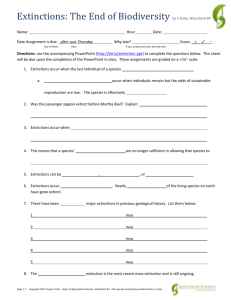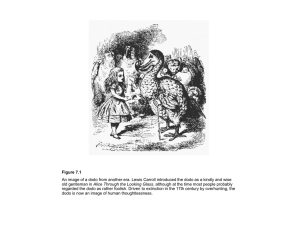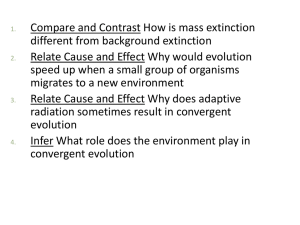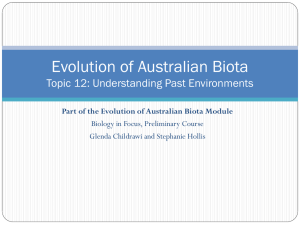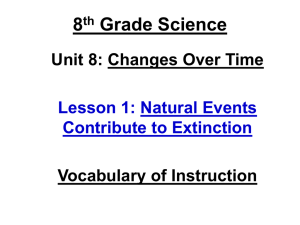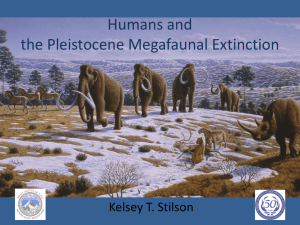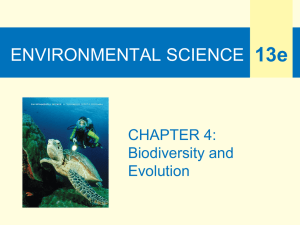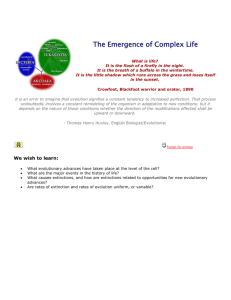Ecological equivalence: a believable assumption for the
advertisement
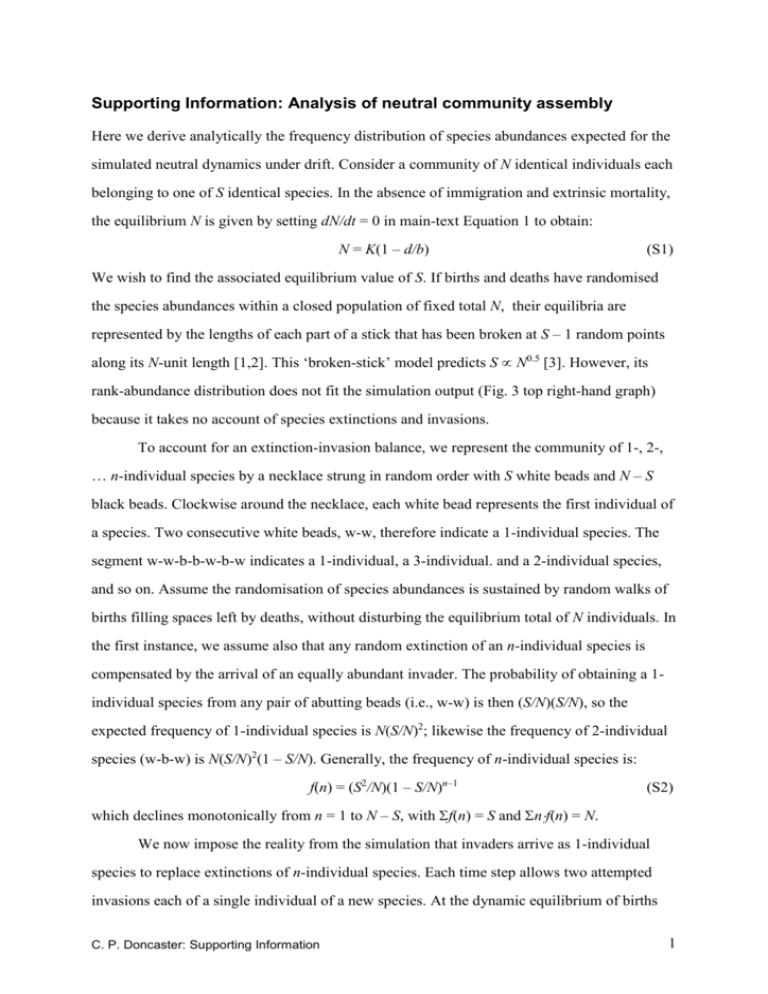
Supporting Information: Analysis of neutral community assembly Here we derive analytically the frequency distribution of species abundances expected for the simulated neutral dynamics under drift. Consider a community of N identical individuals each belonging to one of S identical species. In the absence of immigration and extrinsic mortality, the equilibrium N is given by setting dN/dt = 0 in main-text Equation 1 to obtain: N = K(1 – d/b) (S1) We wish to find the associated equilibrium value of S. If births and deaths have randomised the species abundances within a closed population of fixed total N, their equilibria are represented by the lengths of each part of a stick that has been broken at S – 1 random points along its N-unit length [1,2]. This ‘broken-stick’ model predicts S N0.5 [3]. However, its rank-abundance distribution does not fit the simulation output (Fig. 3 top right-hand graph) because it takes no account of species extinctions and invasions. To account for an extinction-invasion balance, we represent the community of 1-, 2-, … n-individual species by a necklace strung in random order with S white beads and N – S black beads. Clockwise around the necklace, each white bead represents the first individual of a species. Two consecutive white beads, w-w, therefore indicate a 1-individual species. The segment w-w-b-b-w-b-w indicates a 1-individual, a 3-individual. and a 2-individual species, and so on. Assume the randomisation of species abundances is sustained by random walks of births filling spaces left by deaths, without disturbing the equilibrium total of N individuals. In the first instance, we assume also that any random extinction of an n-individual species is compensated by the arrival of an equally abundant invader. The probability of obtaining a 1individual species from any pair of abutting beads (i.e., w-w) is then (S/N)(S/N), so the expected frequency of 1-individual species is N(S/N)2; likewise the frequency of 2-individual species (w-b-w) is N(S/N)2(1 – S/N). Generally, the frequency of n-individual species is: f(n) = (S2/N)(1 – S/N)n–1 (S2) which declines monotonically from n = 1 to N – S, with f(n) = S and nf(n) = N. We now impose the reality from the simulation that invaders arrive as 1-individual species to replace extinctions of n-individual species. Each time step allows two attempted invasions each of a single individual of a new species. At the dynamic equilibrium of births C. P. Doncaster: Supporting Information 1 matching deaths, each invader has probability d of establishing, where d is the per capita death rate in Equation 1. The expected invasion rate is therefore 2d. For established residents, the extinction probability of a n-individual species is [d(1 – d)]n. This is the chance that every one of its n individuals dies without propagating successfully, which diminishes rapidly with n (i.e., rarer species are much more prone to extinction). The corresponding extinction rate is not straightforward to model because it simultaneously depends on, and influences, the frequency distribution of n-individual species. We can at least predict boundary conditions. The lower boundary of f(n) is given by the frequency distribution of n-individual species that results from t rounds of extinction before any invasion. Thus for n = 1 to N – S: f(n) = (S2/N)(1 – S/N)n–1[1 – (d(1 – d))n]t (S3) The community sustains a constant S species if the compound sum of extinctions over t timesteps just matches the total 2td invasions expected after the same t steps. An iterative solution can be obtained for t such that S – f(n) = 2td. The corresponding upper bound of f(n) is given by setting t = 0 to obtain Equation S2, which is realised only if each invading species immediately expands in abundance to fill the space left by each extinction of a nindividual species. As expected, the observed distribution of n-individual species from the 4 Frequency of species, f (n ) Frequency of species, f (n ) simulation lies midway between these boundaries (Fig. S1). A 3 2 1 4 B 3 2 1 0 0 0 10 20 30 40 50 Number of individuals of the species, n 0 10 20 30 40 50 Number of individuals of the species, n Figure S1. Frequency distributions of equilibrium species abundances with fast/slow replacement of extinctions. Observed s.e. frequencies from six replicate simulations (grey bars and vertical lines), and expected if each n-individual extinction is immediately replaced by a n-individual invasion (blue), or expected if t = 7.36 rounds of extinction occur before 2td invasions of 1-individual species (red). (A) K = 1000; (B) K = 500. Other parameters as for intrinsically neutral simulations in main-text Figs 3-4, except X = 0, ω = 1. C. P. Doncaster: Supporting Information 2 DOMINA NTFUGITIVE The good fit of the upper boundary in Fig. S1 for all but the rarest species sustains the negative skew in the log-normal distribution of Fig. 3 top left-hand graph. The higher susceptibility of rarer species to extinction nevertheless pulls down the frequencies of 1- and 2-individual species in Fig. S1 halfway towards the lower boundary, causing the rankabundance distribution to rise above broken-stick expectation in Fig. 3 top right-hand graph. At both upper and lower boundaries, the frequency of 1-individual species, f(1), is a constant per unit area, set only by the character traits of the species (and consequently invariant across Fig. S1 A-B). For example, in the neutral scenario of identical species, 1/f(1) is the minimum area required for each individual to just replace itself on average (see for example [3]). Putting Equation S1 into S3 at n = 1 gives the Arrhenius relation: S c K , where z z 0.5 and f 1 1 d b c t 1 d 1 d 0.5 (S4) Simulations described in the main text show that the values of z and c depend on other lifehistory parameters not considered in this analysis, including species-specific values Ri, bi, ij characteristic of non-neutral scenarios, and X > 0, ω < 1, and faster invasion rate. References 1. MacArthur RH (1957) On the relative abundance of bird species. Proc Natl Acad Sci U S A 43: 293-295. 2. MacArthur RH (1960) On the relative abundance of species. Am Nat 94: 25-36. 3. May RM (1975) Patterns of species abundance and diversity. In: Cody ML, Diamond JM, editors. Ecology and evolution of communities. Cambridge, Mass: Harvard University Press. pp. 81-120. C. P. Doncaster: Supporting Information 3

